Unit 1 The Changing World Topic 1 Our country has developed rapidly. Section C 课件(共49张PPT)
文档属性
| 名称 | Unit 1 The Changing World Topic 1 Our country has developed rapidly. Section C 课件(共49张PPT) | 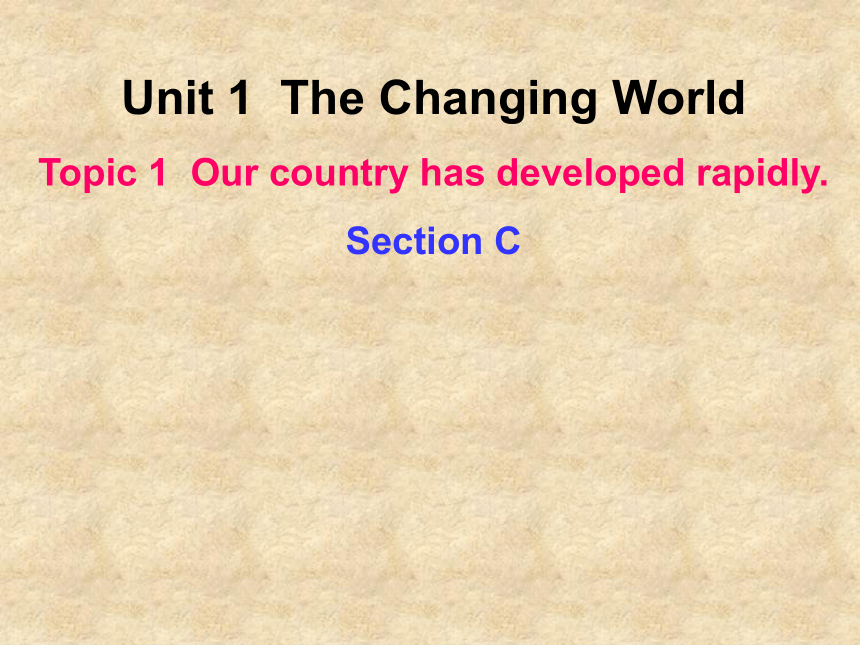 | |
| 格式 | zip | ||
| 文件大小 | 2.9MB | ||
| 资源类型 | 教案 | ||
| 版本资源 | 仁爱科普版 | ||
| 科目 | 英语 | ||
| 更新时间 | 2018-12-19 15:08:01 | ||
图片预览

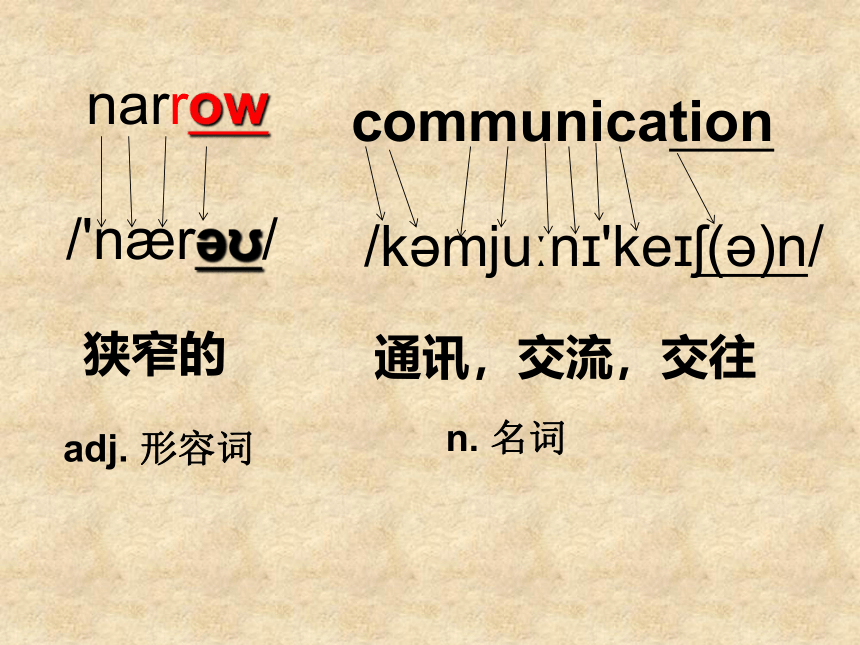

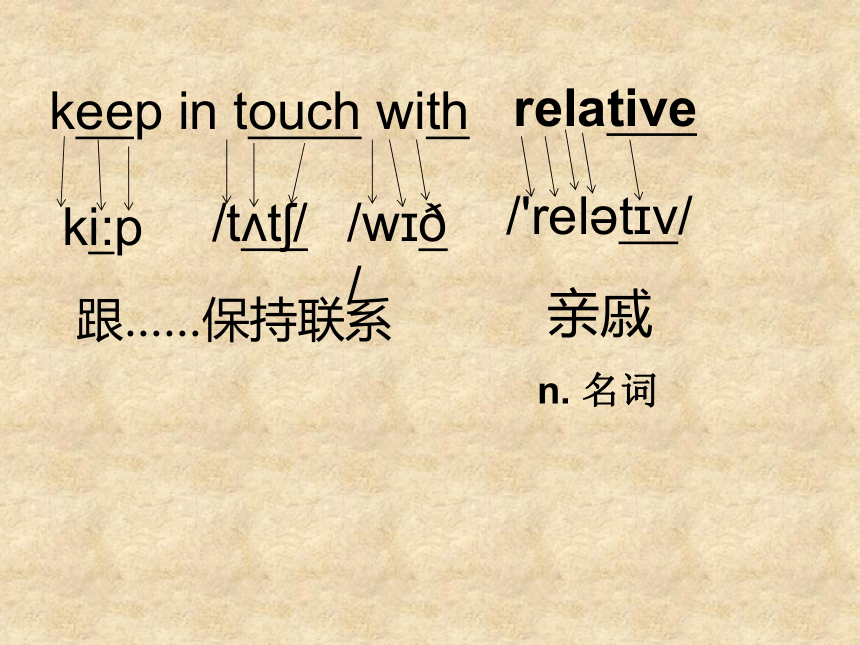
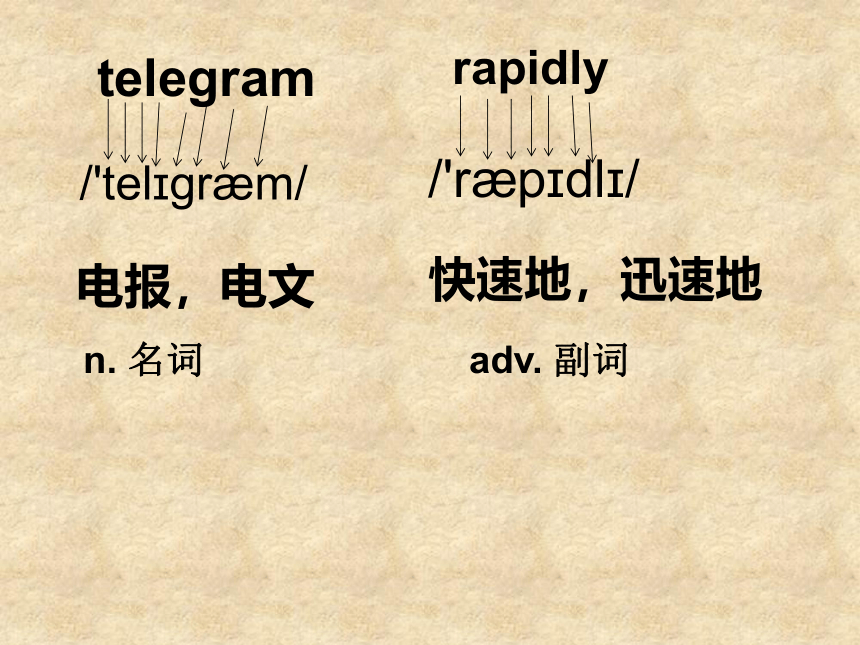





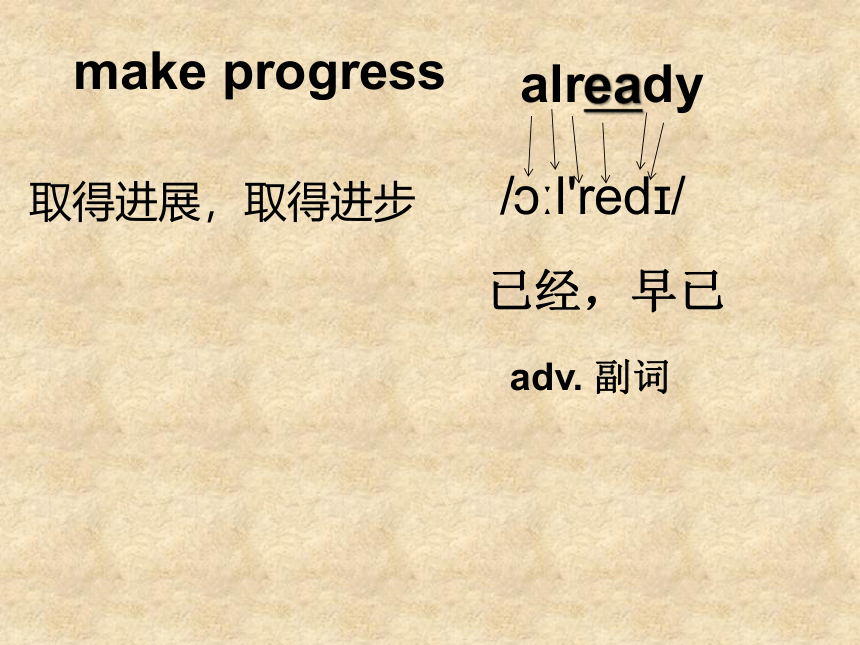
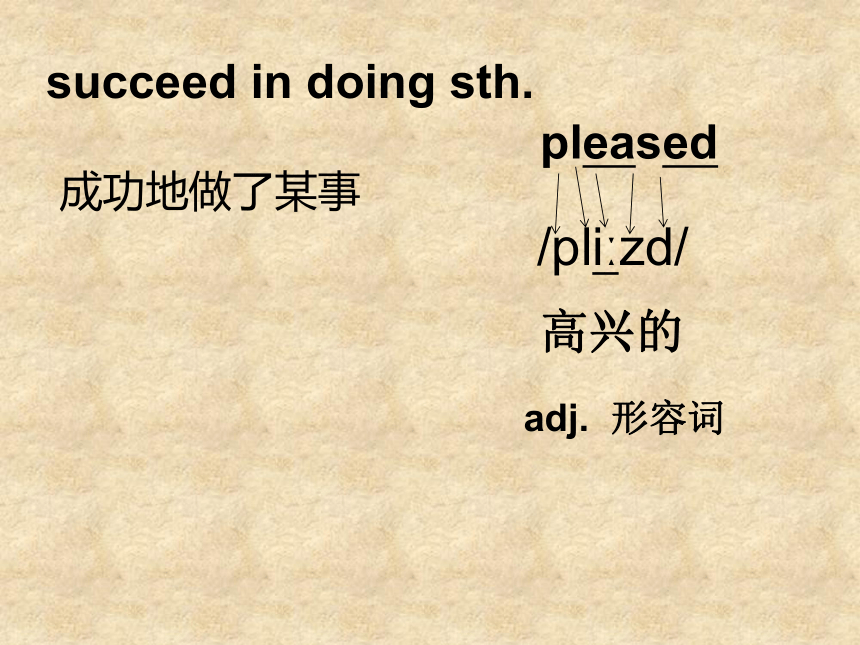
文档简介
课件49张PPT。Unit 1 The Changing World
Topic 1 Our country has developed rapidly.
Section Cnarrow/'n?r??/communication/k?mju?n?'ke??(?)n/狭窄的adj. 形容词通讯,交流,交往n. 名词/'ve?r??s/various各种各样的,
多姿多彩的adj. 形容词report/r?'p??t/报告,汇报n. 名词 & v.动词keep in touch with ki:p/t?t?//w?e/跟……保持联系relative/'rel?t?v/亲戚n. 名词telegram/'tel?gr?m/电报,电文n. 名词rapidly/'r?p?dl?/快速地,迅速地adv. 副词since/s?ns/自…以来;
自…以后reform
/r?'f??m/?改革,改良n. 名词prep. 介词reform and opening-up改革开放satisfy/'s?t?sfa?/使满意,使满足v. 动词adj. 形容词medical/'med?k(?)l/医学的;医疗的cellphone/'self??n/移动电话,手机n. 名词fax/f?ks/传真n. 名词machine/m?'? i?n/机械,机器;n. 名词rapid/'r?p?d/?迅速的,快速的adj. 形容词progress/'pr??gres/进步n. 名词make progress取得进展,取得进步already/??l'red?/已经,早已adv. 副词succeed in doing sth.成功地做了某事pleased/pli?zd/高兴的adj. 形容词Warm-upPhrasesin the past
at present
more than
interview sb.
see sth. oneself
6. in 1960s
7. living conditions
8. enough food
=food enough在过去
现在,目前
超过,多于
采访某人
亲眼看见
在20世纪60年代
生活条件
足够的食物have the chance
to do sth
2.receive a good education
3.see a doctor
4. keep in touch with
get in touch with
lose touch with
5. far away
far away from+地点
faraway有做某事
的机会
获得良好的教育
看医生
保持联系
与……取得联系
与……失去联系
遥远
离……遥远
遥远的develop rapidly
reform and opening-up
satisfy sb. /sth.
be satisfied with
4. medical care
5. make progress
make rapid progress
make progress in
doing sth.快速发展
改革开放
使某人/某物满足
对……感到满足
医疗
取得进步
取得快速的进步
在某事上取得进步
succeed in doing sth
dream about
in a short time成功做某事
梦想,展望
在短时间内Have you ever been to Beijing?Do you know about Beijing?In the 1960s, the living conditions in the city were poor.China has developed rapidly since the reform and opening-up.Look at the pictures of Beijing in the past and at present. Then guess the meaning of each word and the main idea of the text.When reading a passage, try to figure out the meaning of each new word by looking at the pictures or the context of the word.Let's have a trycommunications---simple, slow communications—various , quick, easytelegramfax machinecellphone = mobile phoneseveral differentTask 1
Work alone Read for
main information. What’s the main idea of the passage?
A. Beijing is the capital of China.
B. Beijing has developed rapidly.
C. Some information about old Beijing.
D. My trip to Beijing.Scan the passage in 1a, then answer the question.Underline the topic sentence of each paragraph.Paragraph 1. She has seen the changes in
Beijing herself.
Paragraph 2. In the 1960s, the living
conditions in the city were poor.
Paragraph 3. China has developed rapidly since
the reform and opening-up.
Paragraph 4. It is important to remember the
past, live in the present and
dream about the future.Topic sentences are usually at the beginning or the ending of a paragraph.
Task 2
Class work Read for details Paragraph 1Topic sentence:
She has seen the changes in Beijing herself.see sth oneself 亲眼看见 亲眼目睹I saw him helping others myself.什么是反身代词?反身代词又称为自身代词,表示动作执行者本身。它还可以在句中起到强调的作用,用以加强语气。 Review【粉墨登】 英语中共有八个反身代词,在使用时应注意和它所指的相应的对象在人称、性别、数上保持一致。其基本形式如下表所示:Complete the sentences with the correct forms of the given words.
1. Don’t worry about Jack. He is
old enough to look after ______
(he).
2. –– ____ you ______(see) that
film? What do you think of it?
–– It’s boring. himselfHave seen Paragraph 2:
Topic sentence
In the 1960s, the living conditions in the city were poor.Listen and fill in the blanks. In the 1960s, the living conditions in the city were ______. The roads were narrow and there weren’t many ______ roads. Big families were _________ into small houses. Many families couldn’t get enough food. Few children had the ________ to receive a good education. People ______ little money to see a doctor. And there were _______ hospitals. People kept in touch ______ their friends and relatives far away mainly by letter or telegram.poorringcrowdedchancehadwithe.g. In the 1980s, young people liked dancing the disco.e.g. Most children can receive a good education nowadays.e.g. They moved away five years ago, but I still keep in touch with them.fewAnswer the following questions.
1. Were the roads narrow or wide at that
time?
2. Could most families have delicious food?
3. Why didn’t they see a doctor when they
were ill?
4. How did people keep in touch with their
relatives and friends?They were narrow.No, they couldn’t.Because they had little money. And there were few hospitals.Mainly by letter or telegram.Paragraph 3:
Topic sentence
China has developed rapidly since the reform and opening-up.Read Paragraph 3 and mark T or F.1. China has developed rapidly since the
1940s.
2. There are more ring roads in Beijing than
before.
3. There are various food to eat if you like.
4. Children can study only in modern schools
now.
5. People have no money to see a doctor.
6. People can communicate with others more
easily than before.List four changes in Beijing.1) More and more ring roads and subways have
appeared.
2) Buildings in Beijing are becoming taller and
brighter.
3) There are more kinds of food and clothes to
satisfy people’s needs.
4) Children can study not only in modern schools
but also on the Internet.Translate the words and phrases.
1. He has lived in Hunan ______ (自从) 1998.
2. If you are friendly to others, you’ll have _____________ (越来越多) friends.
3. There are lots of clothes to ____________ _______ (满足人们的需求) in that shop. I like doing some shopping there.
4. Tom is good at sports. He can _______ (不仅) play basketball _______ (而且) play tennis.
5. You can send me the message by ______ (传真).more and more satisfy people’s
needs not only fax since but also Paragraph 4:
Topic sentence
It is important to remember the past, live in the present and dream about the future.Fill in the blanks.
1. Li Ming has ________________
(取得很大进步) in English, because
he studies hard.
2. China has succeeded in _______
(send) Shenzhou Ⅹ into space.
3. I have _______(已经) had lunch.
I am full.made great progress sending already Task 3
Work alone Find out the sentences with have/has done1b Read 1a and match the words and phrases with their meanings.1. communication
2. keep in touch
3. far away
4. progress
5. rapid
6. satisfyA. not near
B. the course of improving or
developing
C. way of sending information
D. to make sb. pleased by
doing or giving them what
they want
E. write or phone or visit very
often
F. happening very quickly or in
a short time= happyTask 4
Group work 2 Work in groups and talk about the changes in your hometown. Then report it to the class. 1. What was/were … like in the past?
2. What has happened to… nowadays?
3. What will … be like in the future?It is important to write a topic sentence for each paragraph to help organize your thoughts.3 Write a short passage on the topic Changes in… You should write its situation in the past and at present based on 2.Changes in Li Ming’s Hometown
Great changes have taken place in Li Ming’s hometown since the reform and opening-up.
In the past, people lived in low houses. The farmers planted crops only with the help of farm animals. Children studied in old schools.
But now, most people live in tall buildings. The farmers can plant crops with the help of farm machines. And children study in modern schools.
Thanks to the government’s efforts, Li Ming’s hometown is becoming better and better.One possible version:summaryWe learn:1. Talk about the changes in a place.
2. Use topic sentences to help us understand or write
a passage.
3. Figure out the meaning of a new word from the context.We can:1. Some words:
narrow, communication, various, report, relative,
telegram, rapidly, since, satisfy, medical, cellphone,
fax, machine, rapid, progress, already, pleased
2. Some phrases:
in the 1960s, keep in touch with, far away, reform
and opening-up, satisfy people’s needs, medical
care, make progress, succeed in doing sth.
3. Some sentences:
I think it is important to remember the past, live in
the present and dream about the future. Homework3. Write a passage on the
topic Changes in…
according to Part 3.1. Read 1a aloud.2. Finish Section C in
your workbook.4. Preview Section D.THANK YOU!
Topic 1 Our country has developed rapidly.
Section Cnarrow/'n?r??/communication/k?mju?n?'ke??(?)n/狭窄的adj. 形容词通讯,交流,交往n. 名词/'ve?r??s/various各种各样的,
多姿多彩的adj. 形容词report/r?'p??t/报告,汇报n. 名词 & v.动词keep in touch with ki:p/t?t?//w?e/跟……保持联系relative/'rel?t?v/亲戚n. 名词telegram/'tel?gr?m/电报,电文n. 名词rapidly/'r?p?dl?/快速地,迅速地adv. 副词since/s?ns/自…以来;
自…以后reform
/r?'f??m/?改革,改良n. 名词prep. 介词reform and opening-up改革开放satisfy/'s?t?sfa?/使满意,使满足v. 动词adj. 形容词medical/'med?k(?)l/医学的;医疗的cellphone/'self??n/移动电话,手机n. 名词fax/f?ks/传真n. 名词machine/m?'? i?n/机械,机器;n. 名词rapid/'r?p?d/?迅速的,快速的adj. 形容词progress/'pr??gres/进步n. 名词make progress取得进展,取得进步already/??l'red?/已经,早已adv. 副词succeed in doing sth.成功地做了某事pleased/pli?zd/高兴的adj. 形容词Warm-upPhrasesin the past
at present
more than
interview sb.
see sth. oneself
6. in 1960s
7. living conditions
8. enough food
=food enough在过去
现在,目前
超过,多于
采访某人
亲眼看见
在20世纪60年代
生活条件
足够的食物have the chance
to do sth
2.receive a good education
3.see a doctor
4. keep in touch with
get in touch with
lose touch with
5. far away
far away from+地点
faraway有做某事
的机会
获得良好的教育
看医生
保持联系
与……取得联系
与……失去联系
遥远
离……遥远
遥远的develop rapidly
reform and opening-up
satisfy sb. /sth.
be satisfied with
4. medical care
5. make progress
make rapid progress
make progress in
doing sth.快速发展
改革开放
使某人/某物满足
对……感到满足
医疗
取得进步
取得快速的进步
在某事上取得进步
succeed in doing sth
dream about
in a short time成功做某事
梦想,展望
在短时间内Have you ever been to Beijing?Do you know about Beijing?In the 1960s, the living conditions in the city were poor.China has developed rapidly since the reform and opening-up.Look at the pictures of Beijing in the past and at present. Then guess the meaning of each word and the main idea of the text.When reading a passage, try to figure out the meaning of each new word by looking at the pictures or the context of the word.Let's have a trycommunications---simple, slow communications—various , quick, easytelegramfax machinecellphone = mobile phoneseveral differentTask 1
Work alone Read for
main information. What’s the main idea of the passage?
A. Beijing is the capital of China.
B. Beijing has developed rapidly.
C. Some information about old Beijing.
D. My trip to Beijing.Scan the passage in 1a, then answer the question.Underline the topic sentence of each paragraph.Paragraph 1. She has seen the changes in
Beijing herself.
Paragraph 2. In the 1960s, the living
conditions in the city were poor.
Paragraph 3. China has developed rapidly since
the reform and opening-up.
Paragraph 4. It is important to remember the
past, live in the present and
dream about the future.Topic sentences are usually at the beginning or the ending of a paragraph.
Task 2
Class work Read for details Paragraph 1Topic sentence:
She has seen the changes in Beijing herself.see sth oneself 亲眼看见 亲眼目睹I saw him helping others myself.什么是反身代词?反身代词又称为自身代词,表示动作执行者本身。它还可以在句中起到强调的作用,用以加强语气。 Review【粉墨登】 英语中共有八个反身代词,在使用时应注意和它所指的相应的对象在人称、性别、数上保持一致。其基本形式如下表所示:Complete the sentences with the correct forms of the given words.
1. Don’t worry about Jack. He is
old enough to look after ______
(he).
2. –– ____ you ______(see) that
film? What do you think of it?
–– It’s boring. himselfHave seen Paragraph 2:
Topic sentence
In the 1960s, the living conditions in the city were poor.Listen and fill in the blanks. In the 1960s, the living conditions in the city were ______. The roads were narrow and there weren’t many ______ roads. Big families were _________ into small houses. Many families couldn’t get enough food. Few children had the ________ to receive a good education. People ______ little money to see a doctor. And there were _______ hospitals. People kept in touch ______ their friends and relatives far away mainly by letter or telegram.poorringcrowdedchancehadwithe.g. In the 1980s, young people liked dancing the disco.e.g. Most children can receive a good education nowadays.e.g. They moved away five years ago, but I still keep in touch with them.fewAnswer the following questions.
1. Were the roads narrow or wide at that
time?
2. Could most families have delicious food?
3. Why didn’t they see a doctor when they
were ill?
4. How did people keep in touch with their
relatives and friends?They were narrow.No, they couldn’t.Because they had little money. And there were few hospitals.Mainly by letter or telegram.Paragraph 3:
Topic sentence
China has developed rapidly since the reform and opening-up.Read Paragraph 3 and mark T or F.1. China has developed rapidly since the
1940s.
2. There are more ring roads in Beijing than
before.
3. There are various food to eat if you like.
4. Children can study only in modern schools
now.
5. People have no money to see a doctor.
6. People can communicate with others more
easily than before.List four changes in Beijing.1) More and more ring roads and subways have
appeared.
2) Buildings in Beijing are becoming taller and
brighter.
3) There are more kinds of food and clothes to
satisfy people’s needs.
4) Children can study not only in modern schools
but also on the Internet.Translate the words and phrases.
1. He has lived in Hunan ______ (自从) 1998.
2. If you are friendly to others, you’ll have _____________ (越来越多) friends.
3. There are lots of clothes to ____________ _______ (满足人们的需求) in that shop. I like doing some shopping there.
4. Tom is good at sports. He can _______ (不仅) play basketball _______ (而且) play tennis.
5. You can send me the message by ______ (传真).more and more satisfy people’s
needs not only fax since but also Paragraph 4:
Topic sentence
It is important to remember the past, live in the present and dream about the future.Fill in the blanks.
1. Li Ming has ________________
(取得很大进步) in English, because
he studies hard.
2. China has succeeded in _______
(send) Shenzhou Ⅹ into space.
3. I have _______(已经) had lunch.
I am full.made great progress sending already Task 3
Work alone Find out the sentences with have/has done1b Read 1a and match the words and phrases with their meanings.1. communication
2. keep in touch
3. far away
4. progress
5. rapid
6. satisfyA. not near
B. the course of improving or
developing
C. way of sending information
D. to make sb. pleased by
doing or giving them what
they want
E. write or phone or visit very
often
F. happening very quickly or in
a short time= happyTask 4
Group work 2 Work in groups and talk about the changes in your hometown. Then report it to the class. 1. What was/were … like in the past?
2. What has happened to… nowadays?
3. What will … be like in the future?It is important to write a topic sentence for each paragraph to help organize your thoughts.3 Write a short passage on the topic Changes in… You should write its situation in the past and at present based on 2.Changes in Li Ming’s Hometown
Great changes have taken place in Li Ming’s hometown since the reform and opening-up.
In the past, people lived in low houses. The farmers planted crops only with the help of farm animals. Children studied in old schools.
But now, most people live in tall buildings. The farmers can plant crops with the help of farm machines. And children study in modern schools.
Thanks to the government’s efforts, Li Ming’s hometown is becoming better and better.One possible version:summaryWe learn:1. Talk about the changes in a place.
2. Use topic sentences to help us understand or write
a passage.
3. Figure out the meaning of a new word from the context.We can:1. Some words:
narrow, communication, various, report, relative,
telegram, rapidly, since, satisfy, medical, cellphone,
fax, machine, rapid, progress, already, pleased
2. Some phrases:
in the 1960s, keep in touch with, far away, reform
and opening-up, satisfy people’s needs, medical
care, make progress, succeed in doing sth.
3. Some sentences:
I think it is important to remember the past, live in
the present and dream about the future. Homework3. Write a passage on the
topic Changes in…
according to Part 3.1. Read 1a aloud.2. Finish Section C in
your workbook.4. Preview Section D.THANK YOU!
同课章节目录
- Unit 1 The Changing World
- Topic 1 Our country has developed rapidly.
- Topic 2 The population in developing countries is
- Topic 3 The world has changed for the better.
- Unit 2 Saving the earth.
- Topic 1 Pollution has causes too many problems.
- Topic 2 All these problems are very serious.
- Topic 3 What can we do to protect the environment
- Unit 3 English around the World
- Topic 1 English is widely spoken around the world.
- Topic 2 Some things usually have different meaning
- Topic 3 Could you give us some advice on how to l
- Unit 4 Amazing Science
- Topic 1 When was it invented?
- Topic 2 I'm excited about the things that will be
- Topic 3 China is the third nation that sent a pers
